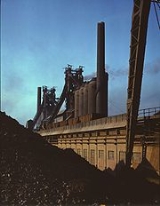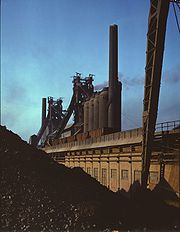
Carnegie Steel Company
Encyclopedia

Andrew Carnegie
Andrew Carnegie was a Scottish-American industrialist, businessman, and entrepreneur who led the enormous expansion of the American steel industry in the late 19th century...
to manage business at his steel mill
Steel mill
A steel mill or steelworks is an industrial plant for the manufacture of steel.Steel is an alloy of iron and carbon. It is produced in a two-stage process. First, iron ore is reduced or smelted with coke and limestone in a blast furnace, producing molten iron which is either cast into pig iron or...
s in the Pittsburgh, Pennsylvania
History of Pittsburgh
The history of Pittsburgh began with centuries of Native American civilization in the modern Pittsburgh region. Eventually French and British explorers encountered the strategic juncture where the Allegheny and Monongahela Rivers meet to form the Ohio...
area in the late 19th century.
Creation
Carnegie constructed his first steel millSteel mill
A steel mill or steelworks is an industrial plant for the manufacture of steel.Steel is an alloy of iron and carbon. It is produced in a two-stage process. First, iron ore is reduced or smelted with coke and limestone in a blast furnace, producing molten iron which is either cast into pig iron or...
in the mid-1870s: the profitable Edgar Thomson Steel Works
Edgar Thomson Steel Works
The Edgar Thomson Steel Works is a steel mill in North Braddock, Pennsylvania. It is active since 1872.-History :The mill occupies the historic site of Braddock's Field, on the banks of the Monongahela River east of Pittsburgh, Pennsylvania...
in Braddock, Pennsylvania. The profits made by the Edgar Thomson Steel Works were sufficiently great to permit Mr. Carnegie and a number of his associates to purchase other nearby steel mills. In 1892, Carnegie Steel Company was formed.
Its headquarters were located in the Carnegie Building, an office building in Downtown Pittsburgh. Built to display the use of steel in its construction, the building was fifteen stories high, and was left uncovered for a full year. The Carnegie Building was demolished in 1952.
Steel mills
Carnegie made major technological innovations in the 1880s, especially the installation of the open hearth system at Homestead in 1886. It now became possible to make steel suitable for structural beams and for armor plate for the US Navy, which paid far higher prices for the premium product. In addition the plant moved increasingly toward the continuous system of production. Carnegie installed vastly improved systems of material-handling, like overhead cranes, hoists, charging machines, and buggies. All of this greatly sped up the process of steelmaking, and allowed the production of far vaster quantities of the product. As the mills expanded the labor force grew rapidly, especially less skilled workers. The more skilled union members reacted with the unsuccessful 1892 Homestead StrikeHomestead Strike
The Homestead Strike was an industrial lockout and strike which began on June 30, 1892, culminating in a battle between strikers and private security agents on July 6, 1892. It was one of the most serious disputes in U.S. labor history...
.
Sale
Carnegie Steel Company was sold to the United States Steel Company in 1901. U. S. Steel was a conglomerate with subsidiary companies. The name of the subsidiary company was changed to the Carnegie-Illinois Steel Company in 1936.Local competition
The presence of the AlleghenyAllegheny River
The Allegheny River is a principal tributary of the Ohio River; it is located in the Eastern United States. The Allegheny River joins with the Monongahela River to form the Ohio River at the "Point" of Point State Park in Downtown Pittsburgh, Pennsylvania...
, Monongahela
Monongahela River
The Monongahela River is a river on the Allegheny Plateau in north-central West Virginia and southwestern Pennsylvania in the United States...
, and Ohio
Ohio River
The Ohio River is the largest tributary, by volume, of the Mississippi River. At the confluence, the Ohio is even bigger than the Mississippi and, thus, is hydrologically the main stream of the whole river system, including the Allegheny River further upstream...
rivers provided a way to transport the heavy materials associated with the steel-making industry. Each plant was located close to or alongside a river.
The seed of the company which became its strongest competitor was sown in 1853. Jones, Lauth and Company established puddling furnaces and rolling mills along the Monongahela
Monongahela River
The Monongahela River is a river on the Allegheny Plateau in north-central West Virginia and southwestern Pennsylvania in the United States...
at a location a couple of miles (roughly four kilometers) away from Pittsburgh
Pittsburgh, Pennsylvania
Pittsburgh is the second-largest city in the US Commonwealth of Pennsylvania and the county seat of Allegheny County. Regionally, it anchors the largest urban area of Appalachia and the Ohio River Valley, and nationally, it is the 22nd-largest urban area in the United States...
. Bernard Lauth
Bernard Lauth
Bernard Lauth was born August 23, 1820 in Alsace, France. He founded the American Iron Works in 1850, and formed a partnership with B.F. Jones in 1851. He invented and patented the process for cold rolling of iron in 1859. In 1871, he purchased the iron furnace at Howard, Pennsylvania, where he...
invented and patented cold rolling of iron in 1859. In the same year, James H. Laughlin
James H. Laughlin
James H. Laughlin was a pioneer of the iron and steel industry in Pittsburgh, Pennsylvania. He was born March 1, 1806 near Portaferry in County Down.-Steel industry:He became a junior partner of the iron business of Benjamin Franklin Jones in 1857...
constructed Laughlin and Company directly across the river from the Jones
Benjamin Franklin Jones (Pittsburgh)
Benjamin Franklin Jones was a pioneer of the iron and steel industry in Pittsburgh. Originally involved in the river barge industry, he purchased a share in American Iron Works in 1851, along with Bernard Lauth. He later joined with James H...
, Lauth and Company. Over time, the two enterprises became united under the name J&L Steel
Jones and Laughlin Steel Company
The earliest foundations of Jones and Laughlin Steel Company were the American Iron Company, founded in 1851 by Bernard Lauth, and B. F. Jones founded in 1852a few miles south of Pittsburgh along the Monongahela River. Lauth's interest was bought in 1854 by James H. Laughlin...
and installed their first two Bessemer converters
Bessemer process
The Bessemer process was the first inexpensive industrial process for the mass-production of steel from molten pig iron. The process is named after its inventor, Henry Bessemer, who took out a patent on the process in 1855. The process was independently discovered in 1851 by William Kelly...
for the production of steel in 1886.
J&L Steel became the most important competitor to the Carnegie Steel Company and U. S. Steel in the vicinity of Pittsburgh
Pittsburgh, Pennsylvania
Pittsburgh is the second-largest city in the US Commonwealth of Pennsylvania and the county seat of Allegheny County. Regionally, it anchors the largest urban area of Appalachia and the Ohio River Valley, and nationally, it is the 22nd-largest urban area in the United States...
. In 1905 it began the construction of a new steel mill along the Ohio River
Ohio River
The Ohio River is the largest tributary, by volume, of the Mississippi River. At the confluence, the Ohio is even bigger than the Mississippi and, thus, is hydrologically the main stream of the whole river system, including the Allegheny River further upstream...
twenty miles (32 km) downriver from Pittsburgh
Pittsburgh, Pennsylvania
Pittsburgh is the second-largest city in the US Commonwealth of Pennsylvania and the county seat of Allegheny County. Regionally, it anchors the largest urban area of Appalachia and the Ohio River Valley, and nationally, it is the 22nd-largest urban area in the United States...
at Aliquippa
Aliquippa, Pennsylvania
Aliquippa is a city in Beaver County, Pennsylvania, United States, within the Pittsburgh metropolitan area. The population was 9,438 at the 2010 census. Formerly a borough, it was formally named a city in 1987 by the Aliquippa Council.-History:...
. In 1908, it constructed a new 12-story office building in Pittsburgh
Pittsburgh, Pennsylvania
Pittsburgh is the second-largest city in the US Commonwealth of Pennsylvania and the county seat of Allegheny County. Regionally, it anchors the largest urban area of Appalachia and the Ohio River Valley, and nationally, it is the 22nd-largest urban area in the United States...
.
J&L Steel announced numerous expansions of its operations, including a $250,000,000 expansion for 1955-58. In 1968, Ling-Temco-Vought, Inc
Ling-Temco-Vought
Ling-Temco-Vought was a large U.S. conglomerate which existed from 1969 to 2000. At its peak, its component parts were involved in the aerospace industry, electronics, steel manufacturing, sporting goods, the airline industry, meat packing, car rentals and pharmaceuticals, among other...
. of Texas
Texas
Texas is the second largest U.S. state by both area and population, and the largest state by area in the contiguous United States.The name, based on the Caddo word "Tejas" meaning "friends" or "allies", was applied by the Spanish to the Caddo themselves and to the region of their settlement in...
, offered to buy sixty-three percent of J&L Steel, marking the beginning of the end for "big steel" in the Pittsburgh
Pittsburgh, Pennsylvania
Pittsburgh is the second-largest city in the US Commonwealth of Pennsylvania and the county seat of Allegheny County. Regionally, it anchors the largest urban area of Appalachia and the Ohio River Valley, and nationally, it is the 22nd-largest urban area in the United States...
region.
20th Century Steel Production
Changes in the way in which steel is produced had already appeared before the Carnegie Steel Company was sold in 1901. Steel manufacturers had begun to abandon the Bessemer convertersBessemer process
The Bessemer process was the first inexpensive industrial process for the mass-production of steel from molten pig iron. The process is named after its inventor, Henry Bessemer, who took out a patent on the process in 1855. The process was independently discovered in 1851 by William Kelly...
and install open-hearth furnaces. Open-hearth furnaces were widely employed until the 1970s when the basic oxygen furnace, electric arc furnace
Electric arc furnace
An electric arc furnace is a furnace that heats charged material by means of an electric arc.Arc furnaces range in size from small units of approximately one ton capacity up to about 400 ton units used for secondary steelmaking...
and continuous casting
Continuous casting
Continuous casting, also called strand casting, is the process whereby molten metal is solidified into a "semifinished" billet, bloom, or slab for subsequent rolling in the finishing mills. Prior to the introduction of continuous casting in the 1950s, steel was poured into stationary molds to form...
made them obsolete. Currently, employment is extraordinarily low at the remaining plants which have been a part of the Carnegie Steel Company since 1900, though in Braddock the J. Edgar Thomson Works is still active, producing steel slabs that are shipped up river to Irvin Works in Dravosburg to be finished coils.
External links
Further reading
- Krass, Peter. Carnegie. (2002). 612 pp., a standard scholarly biography, along with Nasaw and Wall. online edition
- Krause, Paul. The Battle for Homestead, 1880-1892: Politics, Culture, and Steel. U. of Pittsburgh Pr., 1992. 548 pp. excerpt and text search
- Nasaw, David. Andrew Carnegie (2006), major biography along with Krass and Wall. excerpt and text search
- Misa, Thomas J. A Nation of Steel: The Making of Modern America, 1865-1925 (1995) chapter 1 online
- Wall, Joseph. Andrew Carnegie (Oxford University Press, 1970), 1137 pp. a standard biography along with Nasaw and Krass. excerpt and text search

